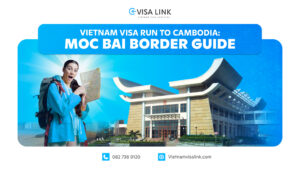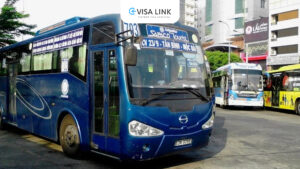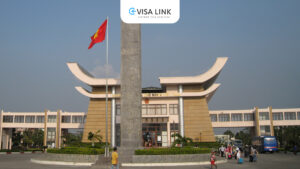Renewing a Vietnam visa, regardless of its type, is consistently challenging, often necessitating expatriates to leave the country. As a result, a lot of foreigners living in Vietnam choose to do a visa run on a low-cost, without any time restrictions.
A visa run entails leaving a country to renew or extend a visa, often by crossing the border to a neighboring country and returning shortly after. In Vietnam, many expatriates or short-term travelers opt for visa runs to Cambodia via the Moc Bai border, allowing them to extend their stay in Southeast Asia conveniently. This guide outlines the process of conducting a visa run from Vietnam to Cambodia, focusing on crossing the border at Moc Bai, ensuring a seamless experience.
What to Prepare Before Departure
For a visa run from Vietnam to Cambodia, it’s essential to ensure you have the following documents in order:
- Your original passport, which must be valid for at least 6 months beyond your planned arrival date.
- A valid Vietnam visa, if necessary for your nationality.
- US$25 for a single and US$50 for a multiple entry visa validating up to 3 months if you are entering with an approval letter for a business visa.
- Obtaining a visa on arrival requires two passport photographs.
Additionally, it’s crucial to arrange transportation for your visa run: Decide on the mode of transportation for your visa run with varied options from buses, taxis, or private cars. Ensure you have transportation arranged for both the outbound and return journeys.
How to handle the Vietnam visa run at the border crossing at Moc Bai correctly
The following procedures must be followed in order to complete a visa run at the Moc Bai border:
- Reaching Moc Bai crossing border
- Leaving Vietnam
- Traveling to and From Cambodia
- Return to Vietnam for an extended stay
Step 1: Traveling from Saigon (Ho Chi Minh City) to the Moc Bai frontier
How to go from Saigon to the Moc Bai border? Yes, there are a number of methods to go from Saigon to the Moc Bai border, including via taxi, private vehicle, city bus, motorcycle, and private bus.
By motorbike/private car:
For most Ho Chi Minh City residents, the quickest route to the Moc Bai border gate via motorbike or car is to head towards Cu Chi and take QL22 until you reach the border, covering approximately 70 km, depending on your starting point.
Tip: While many expats advise against using private cars due to the long and parking issues at the border, some opt for motorbikes to enjoy the scenic route.
By city bus:
Probably the most affordable means to go from Ho Chi Minh City to Moc Bai.
Bus 703 connecting Saigon and Moc Bai
Catch the blue public bus No. 703 at Park 23/9 Bus Station (located across Thai Binh Market, on the junction of Pham Ngu Lao and Cong Quynh Street). As the final bus departs Moc Bai at 4 or 5pm, you should start your border-run early in the day, ideally before 9am, if you wish to leave and return to Saigon on the same day. The trip takes around three hours.
Frequency: Departs every 30 minutes. And just go to Moc Bai Border
By private bus:
You may reserve a seat on a private bus at any office on Pham Ngu Lao Street if you’d rather not ride the city bus, which makes stops at different locations. It costs between $10 to $12 USD.
Step 2: Exit Vietnam
To get to the border gate, you must first park your bike or get off the bus. It will take you five to ten minutes to walk there.
Moc Bai Vietnam border gate
You will arrive at the large Vietnamese building. Proceed completely to the right and continue walking until you come to a large wooden booth occupied by a Vietnamese official. There will be a long queue of people waiting. You may wait in the queue for around half an hour.
After getting your passport stamped for departure, cross the border into Cambodia.
Step 3: Enter & Exit Cambodia
After receiving your Vietnam exit stamp, you must proceed 200 meters to the Cambodian border checkpoint. Once you arrive, go to a small counter to fill out the form and produce your visa, if you received one at the Cambodian embassy or consulate in Vietnam, or pay US$30 for an arrival-only visa to Cambodia. There are some people there who, naturally, urge you to ask for assistance in exchange for money. If you don’t want to, gently say no. Be ready to pay a service charge if you do need their assistance.
Enter the building next to it to “enter Cambodia” after receiving your stamp. There are several tables and chairs on your left as soon as you enter the premises. When the time comes to line up to enter Cambodia officially, stay still and complete the arrival card.
After that, head over to the departure building to get your Cambodian stamp.
Step 4: Re-enter Vietnam
The following are the procedures you must follow in order to finish the visa border run at the Vietnam border:
- On the opposite side, you turn around and re enter the building. Next, you present your passport, Vietnam entrance document (if needed), ATK test certificate, and finish the Vietnam admission process at the Vietnam Immigration building.
- Well done. You’ve returned to Vietnam and have been granted a longer stay. It might take you three to five hours to complete the procedure, depending on if you have the ATK test certificate beforehand. Now ride your bike, bus, or automobile back to Saigon.
Top tips:
- Carry some US dollars with you—roughly $10 or less—as an additional gratuity for the border officers on occasion. Just in case. In addition, there are several food and drink stands where you may get food while the bus is waiting.
- Prepare the precise amount needed for your immigration costs ready.
- Because the bus’s air conditioning might become very cold after three hours of traveling, bring additional clothing.
- Be careful not to alter your port of entry for the visa run, since doing so will need you to get a new visa letter.
A visa run to Cambodia via the Moc Bai border can be a convenient way to extend your stay in Vietnam. By following the steps outlined in this guide and being prepared for the border crossing process, you can ensure a successful visa run and continue to enjoy your time in Vietnam. Safe travels!




